It’s not what you say, it’s how you say it - is this the hidden cardinal rule of interviews?
Mastery of “body language” and understanding what you should and shouldn’t say through utilising body language techniques, has forever been touted as the job interview secret weapon.
Everyone has heard the facts - that something like 90% of all communication is non-verbal. While this fact is not completely on the money, the principle stands - that in moments of high emotion, body language can be, and often is, your most communicative asset.
What is “body language”?
➔ “Body language is the use of physical behaviour, expressions, and mannerisms to communicate nonverbally, often done instinctively rather than consciously”.
So, think about everything you do when you’re not talking. How you sit, how you stand, your general posture, eye contact, when and why you smile, how you use your hands, how you touch or “haptics”, how you sit, how quickly your talk, how loudly or softly your talk, your facial expression, your tone of voice, your personal “space”, fidgeting, doodling, fiddling with the collar of a shirt, rubbing your neck…on and on the list goes.
The HelpGuide piece quoted above says there are 7 types of nonverbal communication. This Verywellmind piece says there are 9.
What cannot be ignored is that you are telling your interviewee or interviewer a lot more than just the content of your words.
Your body tells a message.
Body language is like a compass pointing towards what you really want to say. Your body will convey attitudes, behaviours, and messages based on the way you gesticulate, use eye contact, and tangibly contact or interact with another person from the second you step into a room or onto a Zoom call.
So an awareness of certain cues or nuances in how someone is communicating, such as via certain postures, hand gestures or eye contact gives context - to the words being spoken, and the feelings and emotions of the other person in the room.
An interviewee helping hand.
By deploying certain body language techniques in an interview - some overt, some subtle - a candidate can elevate their interview through displays of confidence, engagement, surety and calm.
Consider your posture - quite literally how you sit in an interview. Research tells us that sitting with arms folded (candidate looks defensive), or sitting facing a door or window (candidate is indicating they want to escape) are critically negative body language traits.
Awareness is power, and by removing those postures from your interview you immediately improve your chances of positive interactions.
An interviewer helping hand.
But body language is also a vital tool to be used by interviewers - they too have to make sure they’re setting the right context as leaders of an interview.
Consider your tone of voice. A commanding and domineering tone of voice may seem authoritative to a business leader who wants to convey leadership, but to many candidates it's overly dominating, controlling, and not welcoming.
Neither interview party wants to be seen as aloof, disinterested, nervous, stressed or rude. So awareness of positive, open and context-led body language techniques is the key to making sure job interviewers are rewarding for both sides of the hiring coin!
The dos and don’ts of interview body language.
DO - practice! Without practice, you’re a leaking ship of emotions and worry, and all the hard work of planning every answer (or question) can be undone by the fact you’re a taut spring ready to explode sitting on a chair. So do mock interviews. Record yourself. Practice, and think - would I hire me?
DON’T - go overboard. There is such a thing as too much gesticulation, and holding eye contact beyond 4 seconds gets a little creepy.
DO - develop emotional awareness. Non-verbal cues are emotionally driven and hard to control without a bit of self-awareness. This means connecting with your emotional triggers and pulls, and being able to read others’ emotional states.
DON’T - zone out on Zoom. Screen-based interviews still offer plenty of opportunity to display job surety via body language, so watch out for looking off-screen too much, or simply not looking at the screen at all.
The bottom line.
Body language mastery requires a lot of self-awareness and some good old-fashioned practice. It’s central to telling the right story about who you are, why you’re good at what you do, and the confidence behind your craft.
Rather than stress over the fact you’re more of an open book than you realise, it’s better to think about our interview body language guidance as a loose set of rules - ones that can be freely interpreted and communicated at will and adapted to meet the needs of each interview.



